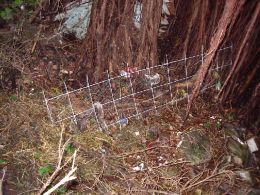
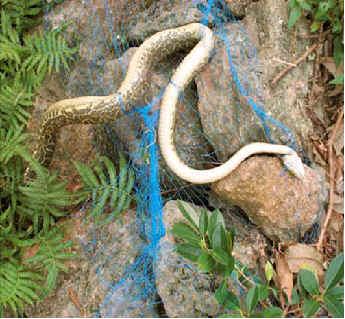
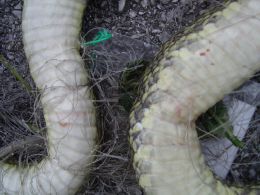
― Decrease venomous or invasive snakes with cheap and maintaince-free traps ―
Visit again to follow new contents. Figures showing example points to set traps. <Aug. 2011>.
Although the followings are explanations on the method to control Habu in Okinawa, Japan, they are applicable to other problem snake species.
Do not to set the traps in natural environments.
Consider
to adopt this method only when the effects to reduce the risk of
venomous or invasive snakes are much more than the problems caused by
the traps.
The costs (prices of materials) are examples in Japan in 2010.



Short net beside a cowshed entangled 2 Habu Habu entangled by a net to protect farming products against birds String of the fishing net constricted the trunk
In subtropical Okinawa and Amami Islands, Japan, a viperid snake Habu {Protobothrops (formally Trimeresurus) flavoviridis]
has been reported to bite over 100 inhabitants each year, with an
incidence of about 1 per 1500 people in several countryside
districts. It is the largest native snake with adults having a
maximum total length about 2 m. Inhabitants have been found to
primarily encounter Habu at a frequency of about 200 times more than
that of bites.
Most of researchers and inhabitants in
Okinawa think it best that human beings and Habu live separately.
Snakes are regarded as god of water in Japan. Habu is an
important native species. However Habu inhabits even in a small
wood in a city and appears in the gardens. About one third of
bite cases occur in houses. Sometimes Habu bites man sleeping in
a room. Even escaping from bites, imagine that you loose a large
Habu in the garden.
Inhabitants
in subtropical Okinawa, Japan have set fishing nets at boundaries of
their houses and caught venomous
viperid snake, Habu. Recent results of the studies on the net-traps
have indicated
the suitable mesh size of the net and effective methods of
utilization of the traps. A good numbers of Habu have been caught in
several experiments in villages in Okinawa. The traps are cheap
with the maximum cost for the materials for a single household: several
hundred yen (several US$), and almost
maintenance-free.
Some Habu are alive on the nets and you should select the points of
setting traps. The
most
suitable locations to set the nets are between houses and adjacent
woodlands or
grasslands, where encounter rates to
Habu are high and children rarely approach. It is impossible
to exterminate Habu even in a
small area in town, and any projects to control Habu should be
continued permanently. Local offices suggest the inhabitants to build snake fences and to
decrease snake-hide holes around their houses. But in most situations
peoples can do nothing to decrease the snake risk. Live-snake box traps
are costly in terms of both finances and labor. Handling live Habu is
very dangerous, and Habu is not regarded as a resource in these days.
Policemen come to catch Habu, but their arrivals are often too late. Populations of Habu will not increase in the future but will not decrease to the levels safe for human beings. At present the net-trap is the only method to
decrease the density of Habu practically and permanently, and would be applicable to other
venomous or invasive snake species.
The
following is an index of the explanations afterwards. Link to abstract PDF file in Japanese
Advantages
of net-trap--------------------------------------
1. Cheap (less than several hundred yen (several US$) for new materials)
2. Almost maintenance-free (with checking once or twice in a
year)
3. Long life (more than 5 to 10 years)
4. Entangling large Habu
Disadvantages
of net-trap--------------------------------------
1. Obstacles at mowing in some sites
2. Danger of live Habu at some spots
3. Unable
to acknowledge the full effectiveness
4. Entangling harmless animals in a few areas
Material--------------------------------------
1. Net
2. Others
Expected
results --------------------------------------
With the nets of total length of several to 30 m, you can catch 1 Habu
a year (mainly large Habu with preys in stomach). In high
density
areas of Habu, one net would entangle several Habu in
succession.
However, at spots with weeds or debris the bones of Habu are hard to be
discovered, and the users would underestimate the trapped numbers of
Habu.
Examples of good results and trapping rates at the experiments
How to estimate snake species and sizes of Habu by bones
How to
use --------------------------------------
There are several types of the
net-traps, and most of them have succeeded to entangle Habu.
Among them the nets fixed
onto an iron frame (grids or wire) have the following advantages:
applicable to most variable situations, easy to set, and scarce
to become obstacles. The net-traps catch Habu accidentally
passing by, and longer nets could catch more Habu. The net is not for
the barriers to keep out Habu, and you do not need to expand the
net fully at setting. Unless the nets are buried under weeds
and
debris, and if the top of the net is more than 20 cm high
above
the ground, the nets are capable to entangle Habu.
Selection
of setting points:You
can not set the net-traps everywhere, as some captured Habu are alive
and harmful. Inhabitants
have been encountered Habu within about 20 m distance from
woodlands and
grasslands. The
most
suitable locations to set the nets are between houses and these areas,
where few inhabitants would approach. If children might pass
the
target sites, you should set the traps several meters inside the
woodlands or at high positions of embankments made of limestone rocks. The
areas without sunshine are preferred for the setting points,
like shaded areas in woodlands and beside buildings, as
no weeds grow on the ground. Especially, long nets are not suited at
the spots with frequent weeding. If no Habu are caught during several
years, you had better move the traps. As gravid females with fatty
trunk have high chances to be entangled, you could catch them by
setting the nets at egg-laying spots like limestone rock embankments
between mid-June and mid-July (pre-season of egg-laying).
While the most effective type of the trap is a short net fixed
onto an iron frame (grids or wire), you can choose the
type suited to your environment among the following types.
1. Short
net fixed
onto an iron frame (grids or wire)
2. Net of about 10
m in length
3. Small
net set in a gap among limestone rocks
4. Net of
more than 30 m in length (for institutions or local groups)
Applications of
the traps to problem snake species in other regions
-----------------------------------------
Venomous or invasive snakes are causing great problems for human health
and native animals mainly in tropical and subtropical regions. In many
cases the net-trap method could be applicable with
respect to its cost effectiveness and
ease of use.
1. How to select mesh size
2. How to utilize
***********
The followings are detail
explanations of those above *************
1.
Cheap
(The followings are
costs of 4 short nets with iron frame and one net of 10 m in length)
(1) Discarded materials
Cost is zero. In
the case of purchasing a great amount of discarded fishing nets, the
costs are less than 2 yen per 1 m x 1 m, 8 yen (10 cents) for 4
small nets and 20 yen (25 cents) for a net of 10 m in length.
(2) New nets and iron frames
Fishing net: a net of #2 string, 25 mm mesh and 100 m x 2 m at expanded
form costs 3600 yen (45 US$), That is 18 yen (25 cents) for 1x1 m, 72
yen
(90 cents) for 4 small nets and 180 yen (2.20US$) for a net of 10 m
in length.
Iron grids with plating: A unit of material of
4 mm wire, 15 cm x 15 cm grids and 6 m x 1.5 m size costs 4400 yen (55
US$). From
this unit, we get 26 short frames (about 0.7 m long), 170 yen (2 US$)
per frame, 680 yen (8.50 US$) per 4 frames.
Iron grids
without plating: A unit of size same to the previous one costs 2800 yen
(35 US$), 110 yen (1.30 US$) per frame, 440 yen (5.50
US$) per 4 frames.
Total costs for 4
traps (net + frames) of the previous two mterials:
750 yen (9 US$) with
planted frames, 510 yen (6.40 US$) with un-planted frames.
Wire:
For example, a unit of 2 mm diameter and 20 m in length costs 250 yen
(3
US$). For one trap, we use 3.3 m which costs 40 yen (50 cents), for 4
traps 160 yen (2 US$).
Total costs for 4 traps (net + wire): 230 yen (2.90 US$).
(Most of the costs shown
above are calculated by dividing the costs of large units by the
numbers of pieces. Costs are higher at buying each small piece.)
2.
Almost maintenance-free
(with checking once or twice in a year)
(1) It takes half to 1 hour to prepare (cutting) the materials and to
set the 4 short traps or 1 trap of 10 m in length.
(2) After setting, you would check the traps once or twice at
most in a year. Clean of fallen leaves and debris. When the short traps
have fallen down, put up them again. When the long nets have
slipped down, hang them again. If you can not set the traps steadly,
tie the frame or net to some support, or in the case of a trap with
iron frame, set 1 or 2 traps in an "L" or "T" shaped formation. These
works would take about 10 minutes and suited to be in the post-season
of typhoons. All types of traps have potentials to entangle Habu, if
the tops of them are more than 20 cm above the ground or walls, and
need not be set exactly. If you set the short traps steadily and do not
want to know the results of trapping, you do not need checking them at
all. If you find live Habu on a trap, you can beat it or spray
snake-killing medicine, while Habu would die by itself without these
treatments. You should not try to catch Habu alive, for handling Habu
is quite dangerous.
3.
Long
life (more than 5 to 10 years)
All the
materials have long lives of more than 5 to 10 years, based on
the result that we have used discarded fishing nets of weak string for
more than 3 years.
A net remains effective as a trap even if several parts of
it have
been ripped.
4.
Entangling
large Habu
Most of the Habu that have been captured were large snakes with
stomach content, mainly a rat or a musk shrew. In order to reduce the
risk of Habu, the number of large snakes should be
reduced, as these snakes have large quantities of venom, and large
females are capable of laying many eggs, which would increase the
population size. Moreover, the longevity per year is estimated to be
nearly constant for adult Habu of any age, which makes the remaining
days similar among adults of various sizes. A gravid Habu has
been
entangled by a trap, and to catch gravid females before egg-laying is
most effective to decrease the snake population. You can catch these
females by setting traps at embankments made of limestone rocks, the
gaps in which are ones of the main egg-laying sites.
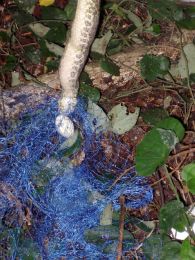
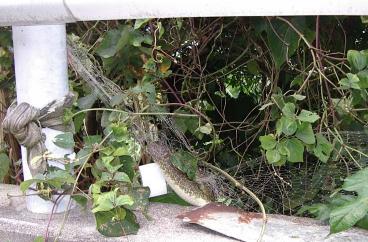
A gravid female with ripe eggs was entangled Long net hanged from guardrail caught Habu
1.
Obstacles
at mowing in some sites
The nets become obstacles at mowing, especially long nets set at
sites with frequent mowing. Even if several parts of the net are ripped
at mowing, the other part of the net still can entangle Habu. Short
traps
with iron frames can be moved during mowing and would not be obstacles
in most sites.
2.
Danger
of live Habu at some spots
Half of Habu having
been entangled at night die before the following morning. Live Habu
dies under the sunshine in 30 minutes without controlling its body
temperature. A few Habu trapped in the sunshade are alive and dangerous
for
children without understanding the danger. When the target spot has
passengers including children, you should not expose the traps. At such
a spot you could set the traps several meters inside the nearby
woodlands
or at high positions of rock walls where children can not approach. In
the cases that you can explain the danger of Habu to children or that
adult
persons can check the traps every morning, you can set traps
in
your garden. When an entangled Habu is dangerous, beat it or spray
snake-knock medicine.
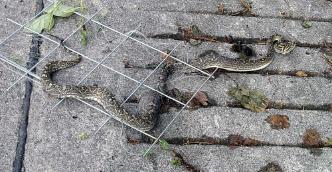
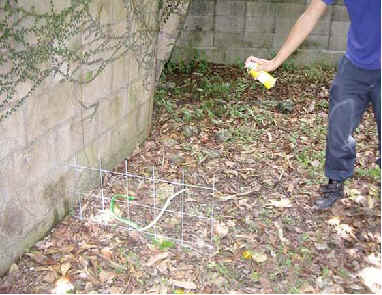
Short trap with live Habu was moved to the road from adjacent wood Spray snake-knock medicine at danger
3.
Unable
to acknowledge the full effectiveness
You can get good motivations on the works of controlling Habu
when you discover the entangled Habu. However the bones of Habu are
small and you can not find the bones in weeds or under fallen leaves.
Habu sometimes rotates on the long net and is entangled in complicated
manner, in which case its bones remaining on the net can be discovered
for more
than one year. Habu does not rotate on a short trap with iron frame and
does not remain its bones on the net. The body of Habu becomes rotten
to bones in one or half month, which indicates that the numbers of
entangled Habu are 12 to 24 times more than the discovered ones at
checking the traps once per year.
4.
Entangling
harmless animals in a few areas
The
net-traps also catch animals other than Habu. Almost all snakes are
Habu in the cases of short-traps with iron frame and 25-mm mesh net. It
is convenient to catch other venomous snake Himehabu, invasive snake Elaphe
taeniura and invasive African snails by the net-traps.
When other
animals native and without any risk, such as non-venomous snakes Dinodon and
river crabs for example, are entangled in considerable numbers, remove
the traps or move them to other points.
(The
following costs may vary among shops and periods)
1. Nets
The
most suitable mesh size of net-trap for Habu is 25 mm (between the
adjacent knots) while nets of 20-30 mm meshes have entangled Habu.
Fishing nets of fine (#2-3) thread are good for handling while
you
can utilize nets
to protect farming products against birds and nets for golf-exercising.
Discarded nets are also usable, even if they have rips or their strings
have weakened. The suitable fishing nets are those 7-"setsu" mesh (25
mm) in Japanese (or 6.5-"setsu", 28 mm mesh). An example cost of one
roll of net, #2 string, 25 mm mesh,
30-"kake"
x
50-"ken" (about
1.2 m x
55
m in expanded form) is
2300
yen (21 US$). Nets with heavier string
are more expensive and difficult to be stocked, moved and handled.
Either twined or mono-fiber string will do for the net-traps, but the
nets of twined
strings are easy
to be cut in small peices and
to be set close to the ground. The nets of mono-fiber strings have the
following advantages; easy to fix on limb-stone walls, adopted to set
simply on the ground by
swelling themselves.
When you use
the roll of 1.2 m x 55 m, cut one roll to get short 2 rolls (60 cm in width), as these are enough widths for
net-traps.
By cutting
these mini-rolls, get pieces of net of 1 m in length for short-traps
and
of 10 m in length for long-traps. These lengths of net are those of
nets at expanded form (mesh shape: nearly square). You can set
a long
net
easier when you have tied a short colored string at one corner of the
net as
a mark just after cutting it.
See PDF file in Japanese, showing
how to cut the net roll
2.
Other materials
Iron frame with grids: a unit is 6 m
long and 1.5 m wide, and that of 4 mm wire with
zinc-plating, 15 cm x 15 cm grids costs 4400
yen (55 US$) and that without plating 2800 yen
(35 US$). A unit of more slender wire (3 mm) is more
suited to the traps, but is hard to get. A unit with 10 cm
x 10 cm grids will
do, but select that of 15 cm x 15 cm at choice.
Examples
of cutting a unit of iron grids are; cut the unit to pieces of frame
with width of 2 or 3 grids (30 or 45 cm wide) leaving long and short
cut-end as stakes at setting and projections of fixing nets,
respectively. As a result, 13 frames with the projection of 5
cm
at the top
and 10 cm at the bottom can be made
by 30 cm (or 45 cm) in height 150 cm in length. By cutting these frames
into 2 pieces, you get 26 frames of 60 cm or 75 cm in length. You need
not
cut the frames of 150 cm length, but the shorter frames are good
for transporting and handlings. You can arrange
several short
traps, when you need a long trap at installation.
How to cut the unit of iron grids: see PDF file in Japanese from here
When you install many short traps at once, transport the frames and nets separately to the target sites, because the netted frames are easy to get twisted mutually.
How to use cheap wire instead of iron grids: see PDF file in Japanese from here
Frames
for "micro" net-traps set in gaps of embankments made of
limestone rocks: Prepare
zinc-plated iron net of 3 to 9 mm mesh, and cut it to pieces of 2 to 3
cm
in width and 30 to 100 cm in length. Then make circular frames
of 10 to 30 cm in diameter from these pieces by
twining both
ends (or
tying with wire). After fixing net on the frame, each trap is
partitioned with paper, because it easily gets twisted with other traps.
Three
examples
of good results in south part of Okinawa
Island,
1) A net-trap with
iron frame of 1.5 m in length entangled 2 Habu in 4
months
in Nanjo City.
2) 30 or more Habu have been captured by nets of 20 m
in total length installed on an embankments made of limestone rocks
beside a
house in about 30 years in Haebaru Town.
3) One Habu was captured
within one
week by a net-trap of about 10 m in length in the
vicinity of the residence in Haebaru Town.
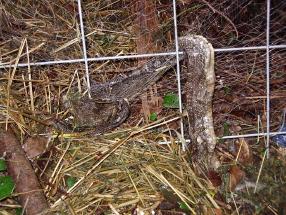
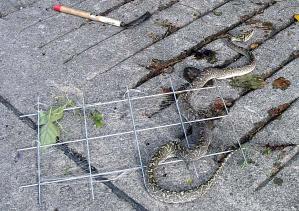
Two
Habu were caught in 4 months
Live Habu was found entangled by a
short trap
installed in roadside woodlands
The
trapping
rate (converted to the number of Habu caught per net of 10
m in length per year) of the short net-traps with iron grid frame
ranged from
0.67 to 2.8, 1.4 in total, with checking every two months. These are
the
undervaluation rates based on the numbers of only discovered snakes,
and
remain the possibility of real rates several times higher than
these.
Under the assumptions of the longevities of the materials as, 1)
zinc-plated iron frame: 15 years and 2) fishing net: 5
years, the cost
of materials to capture one Habu is estimated to be about
150 yen.
Habu
is distributed concentratedly in fields and its density varies
greatly even in
one area.
Therefore, there are a few points of trapping rates higher than and a
lot of points of trapping rates lower than the mean rates shown above.
When no Habu were caught by setting traps of several meters in total
length for several years, the spot is assumed not to suffer a high
density of Habu. In those cases, change the spots to install traps.
How
to estimate snake species and size of Habu from the bones
1. Identification of Habu
from the bones
Among
the bones of snakes vertebrae are discovered most easily, but
it
is hard to identify snake species by vertebrae. It is
difficult
to find Habu fangs because there
are only two fangs of about 1.5 cm in length even in Habu of 1.5 m in
total length. It is easy to find the biggest bones, mandibles which are
2 in number but are 4 cm long in Habu of 1.5 m in total length.
2. Estimation of
size of Habu
Fang: Total length of Habu is estimated by multiplying 100 to the
distance between both ends of the fang.
Mandible: Total length of Habu is estimated by multiplying 35 to the
distance between both ends of the mandible.
Vertebra:
Total length of Habu is estimated by multiplying 200 to the minimum
diameter at horizontal level when long projections are situated at
vertical positions.
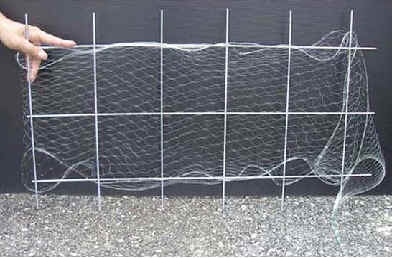
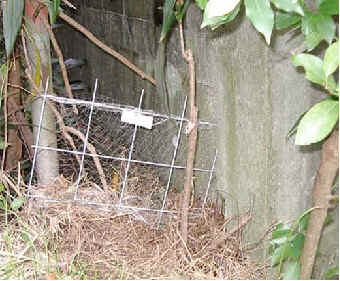
A net fixed on iron frame of grids An example of installing a trap between house and woodlands
(Similar type of traps with wire: PDF
file in Japanese from here)
(1) Fix
net on the iron frame
(for example, about 70 cm in length). The frame is wrapped loosely by
the net at either one or two sides.
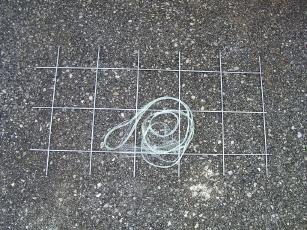
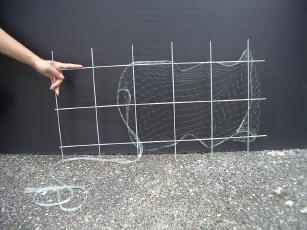
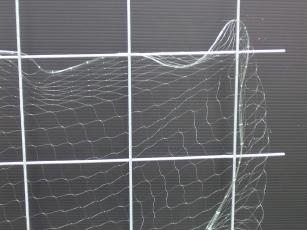
Net and frame Fix the net loosely Make the mesh expand
Examples of set points of net-traps in or near a house and farmlands (Blue mesh: trap; blue area: house-building and space for resting near the farmlands; green area: garden; yellow area with green symbols: woods and large tree in garden; brown area with dots: path and road; white area with red and green symbols; farmlands)
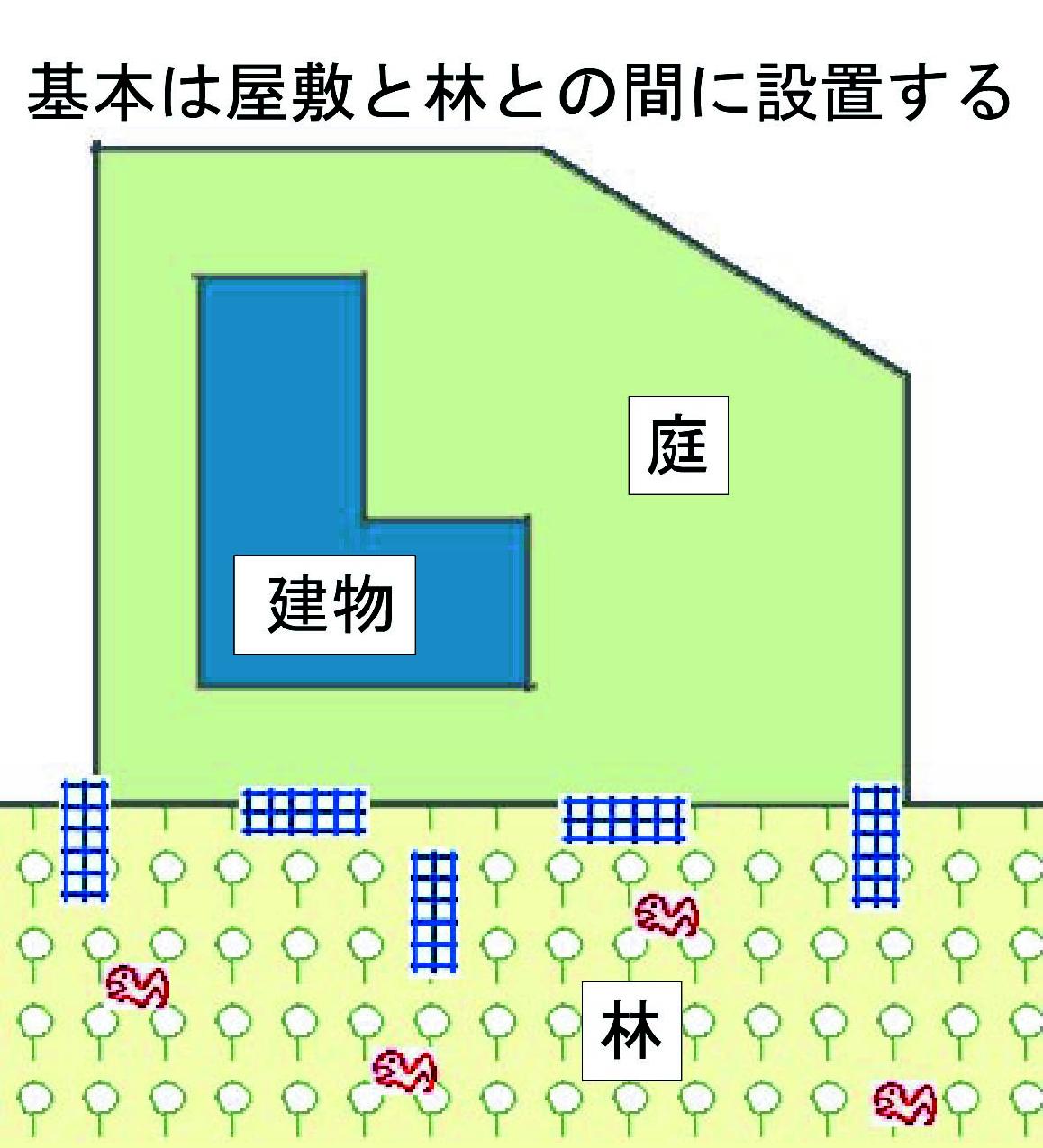
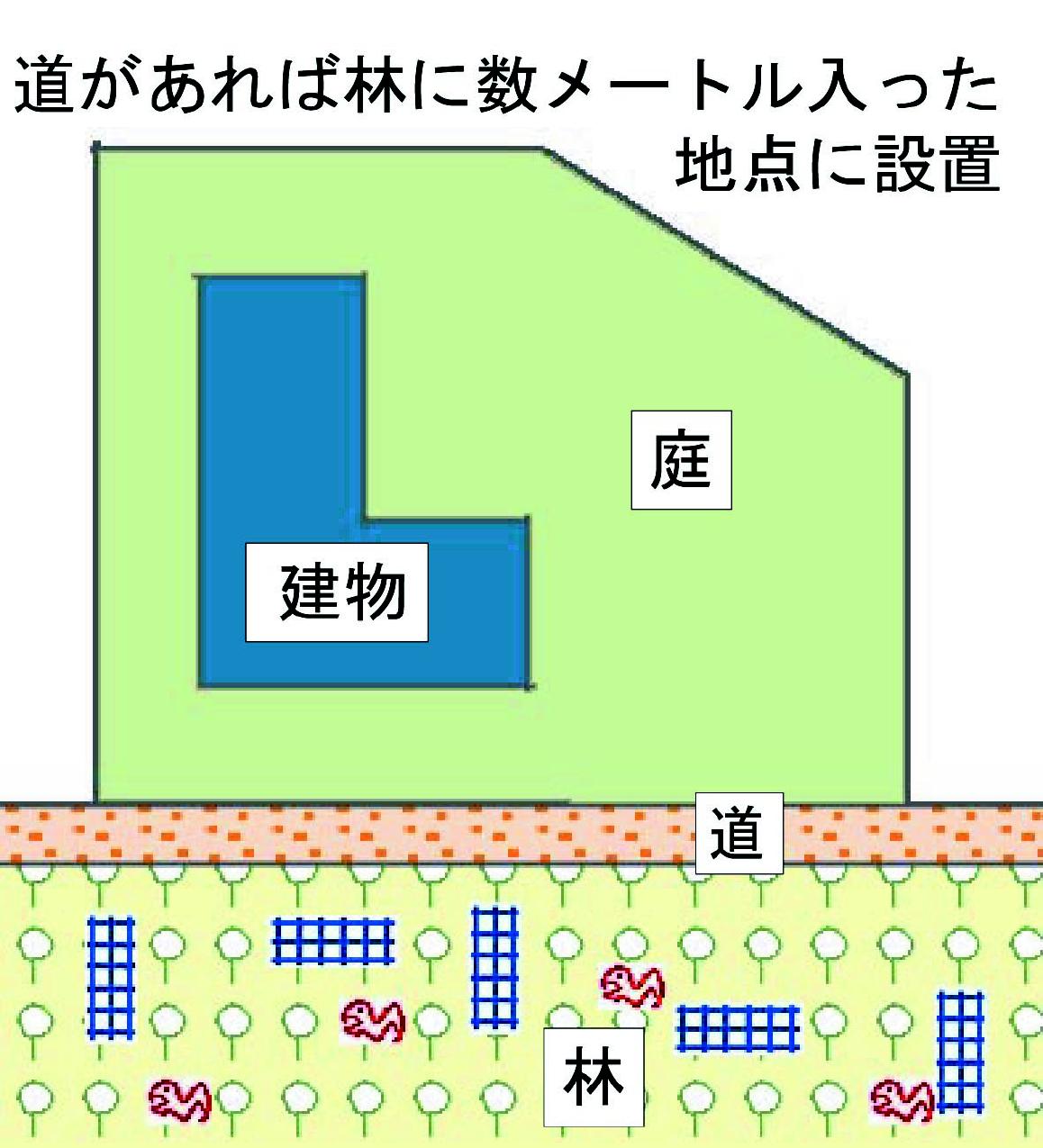
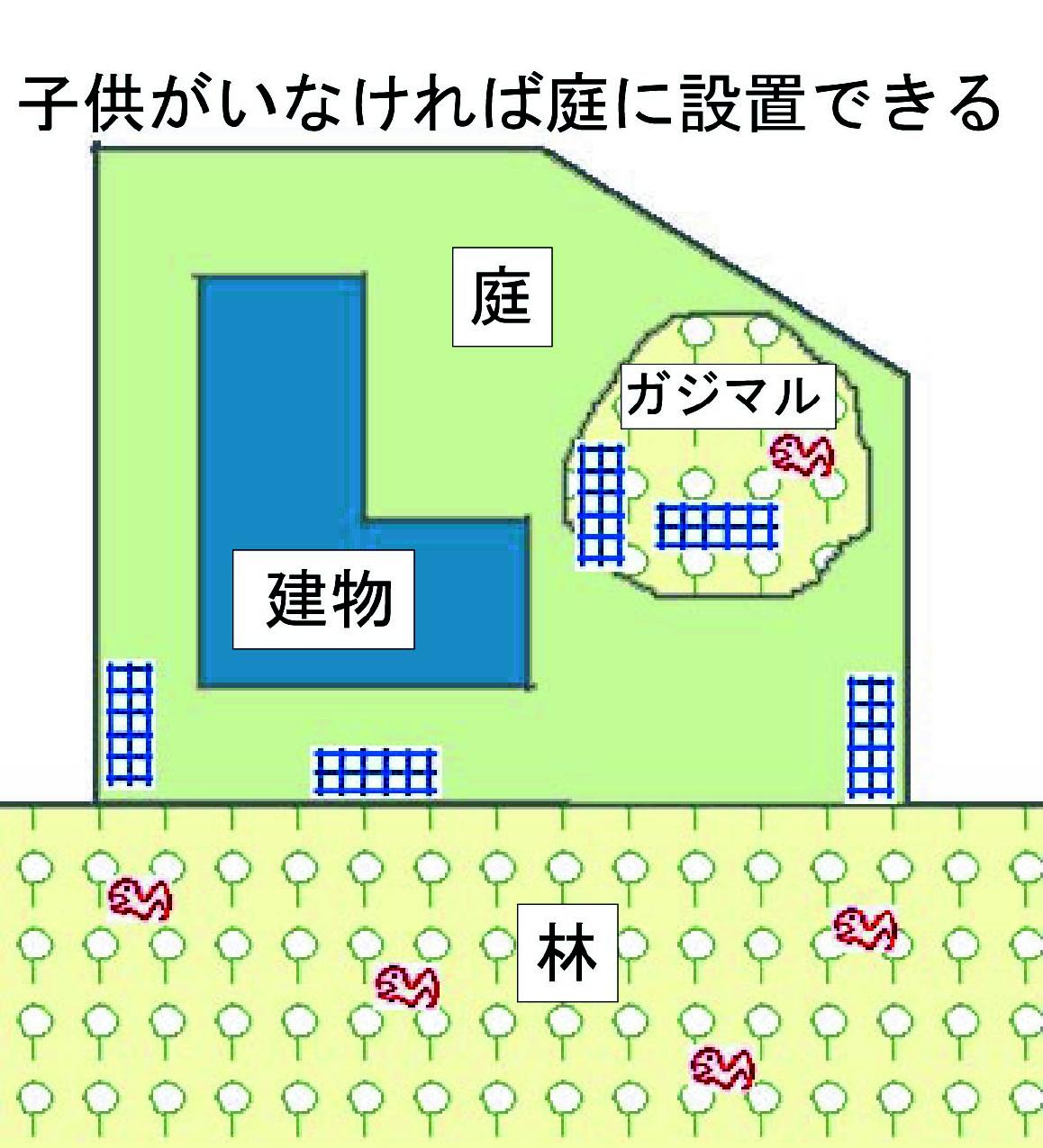
Basic points are between a house and woods. When a path is there, several meters inside the woods. In the garden without children.
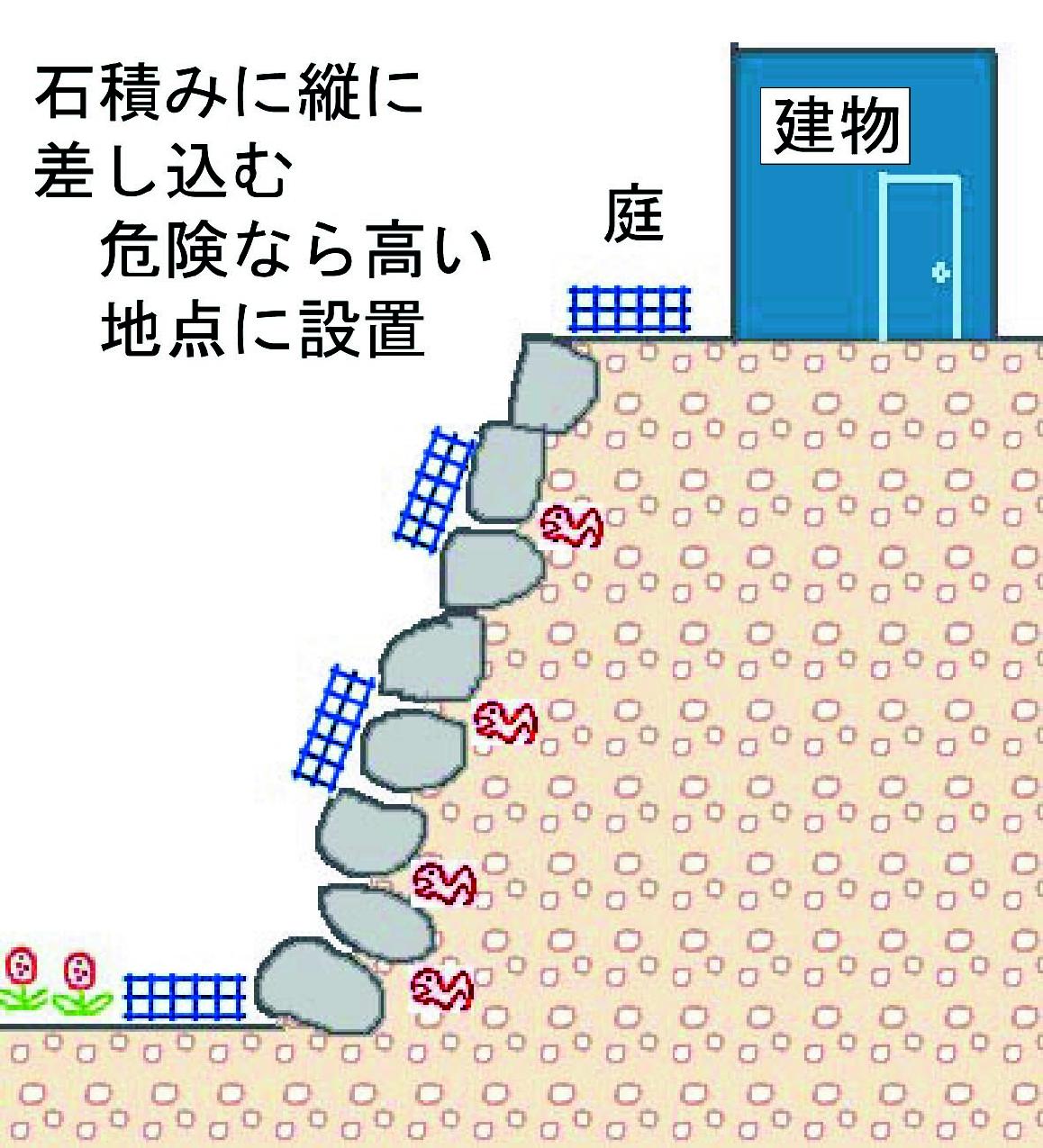
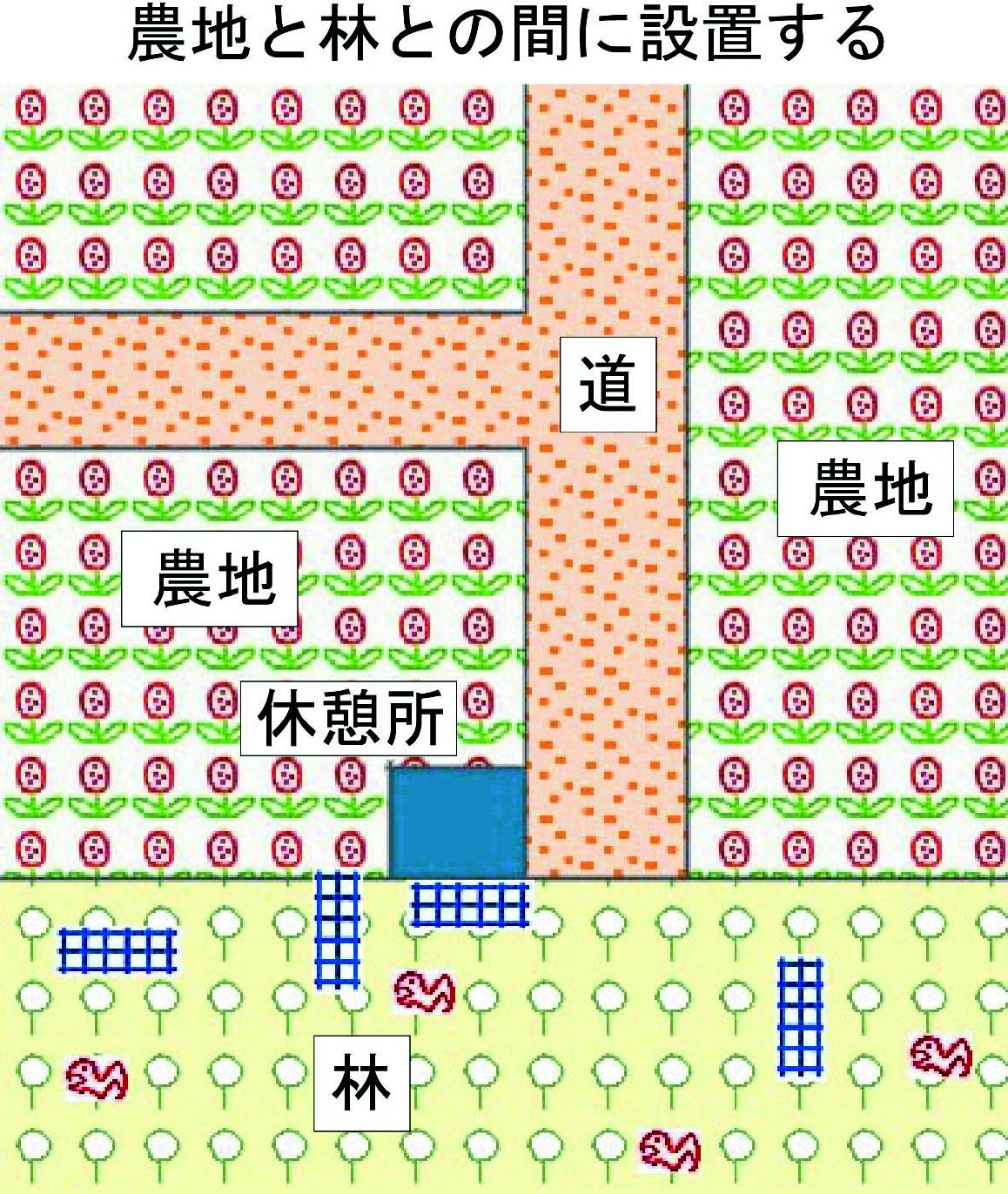
(2)
Set the
traps at the points of high density of Habu, in the
following manners.
Habu might be alive, so avoid the points where
children pass.
Set 4 to 6 traps per single house. (Suited spots are
those along the walls, fences and greenhouses where Habu is expected to
pass by).
Cut-ends could be pierced into the gaps of rock embankment
where Habu hides himself. In this case, set the traps vertically not to
gather fallen leaves by the nets.
In both types of setting when the
traps seem to fall easily, fix the upper parts of the traps to branches
and etc. with wire. Otherwise, bent a trap or combine two traps to make
an "L" shaped formation.
Check the traps once or twice per year, and
lift up the fallen traps. If you would search and find bones of Habu at
the bottom of traps, you can acknowledge the effectiveness of the
traps.
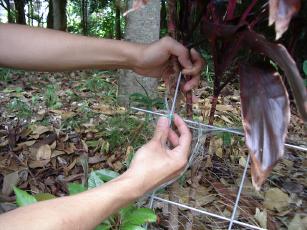
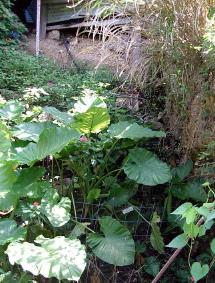
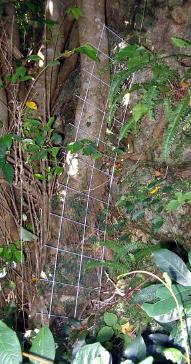
Tie a trap to small tree A trap set under leaves Trap pierced in gaps of rocks
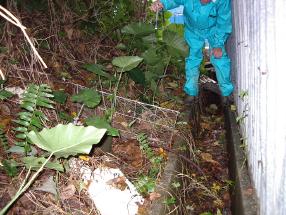
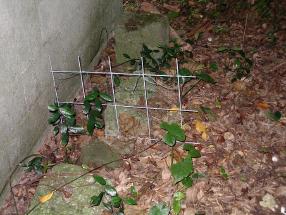
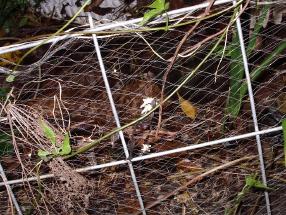
Capture spot at the back of a working house Installation along fence Vertebrae of captured Habu
(3) Easy points
of utilization
Easily
installed.
Hardly loosing the effectiveness (scarcely to be
buried in fallen leaves without falling down)
Hardly regarded as
obstacles
Easy to move
Adjustable in the trap length
(4) Disadvantage
Expected number of Habu encountering one trap is small
Refer to the material, for the materials and preparation PDF file of detail explanations from here
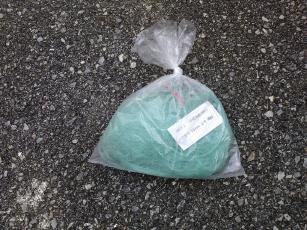
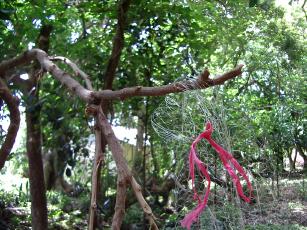
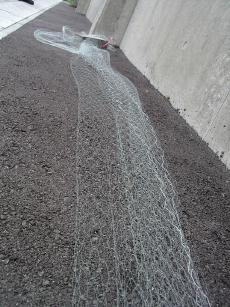
Fishing net of about 10 m in length Hang down the net from branches (bottom is suppressed by stones and etc.) Net extended on the ground surface (mono-fiber string is suited)
(1) Examples of
installation
Habu might be alive, so avoid the
points where
children pass.
Cover the rock embankment (by fixing the net to rock
edges, by suppressed in gaps of rocks with stones and by tying to small
trees).
Hang down to the ground from the hedges, guardrail and tree
branches. When the net bottom is above the ground suppress it with
stones and etc.
Extend the net on the ground as forming swelling of
net. In this case choose a spot without weeds and a net of mono fiber
string is suited.
(2) When the trap is covered by fallen leaves, clean
of them. You can check the effectiveness of the trap by searching bones
of Habu at the bottom of the net.
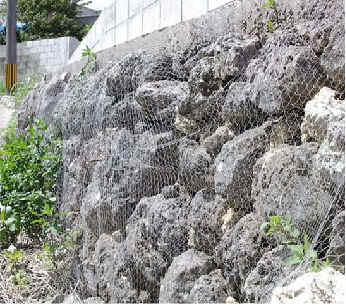
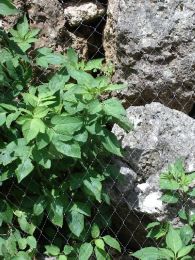
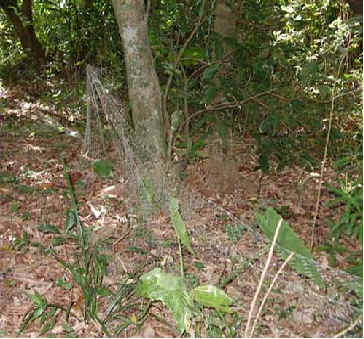
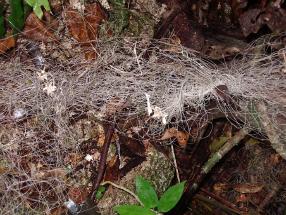
Ten-m long net covering rock embankment Net becoming obstacle at weeding Net in woodlands with no weeds Bones of entangled Habu on 10-m net in woodlands
(3) Easy points
at utilization
Need not to expand the net fully
Effective with rips or slacks on the net
Effective if the height
is more than 20 cm from the ground in the nets hanged from branches or
hedges.
(4) Disadvantage
Unsuited in the weedy points with weeding.
(usable in weedy points with utilization of herbicide, suitable points
are just inside the woodlands beside residential and farming areas,
without weeds)
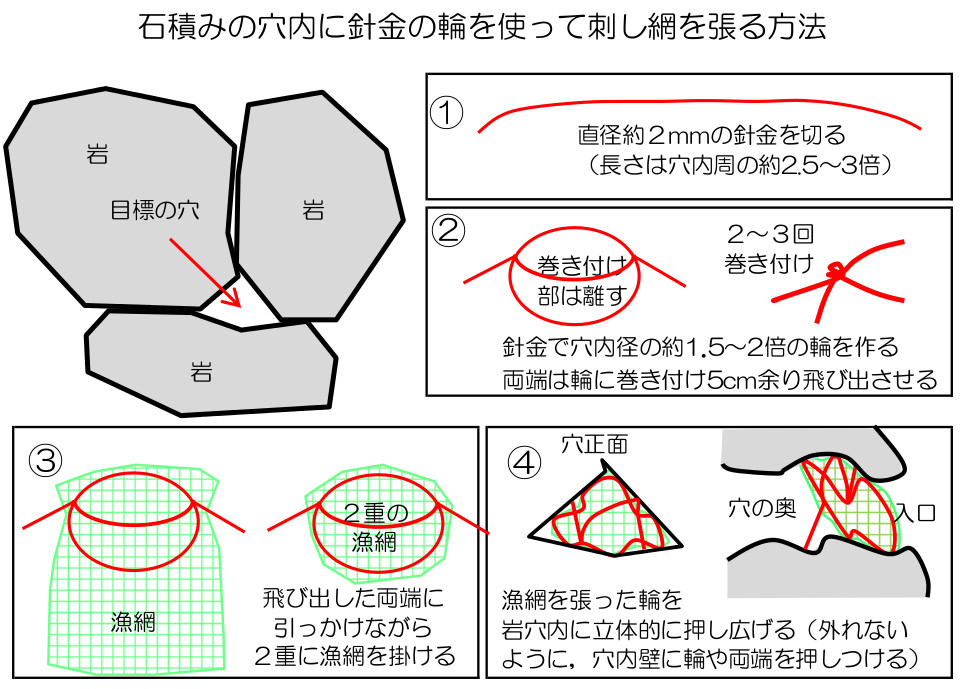
(1)
Fix
the net loosely on the both sides of wire-net frame of 10 to 30 cm in
diameter. Prepare more than 20 frames of various diameters. Separate
the frames with net each other with paper, because they get twisted
mutually during stocking and transportation.
(2) Choose a trap size in
accordance with each gap size among rocks.
(3) Set each trap in each
gap in the embankment.
Habu might be alive, so avoid the
points
where children pass.
Fix the trap frame at edges of rocks for firm
installation.
Put stones in the frame or expand the frame by fingers
when the trap is loosely fixed in gap.
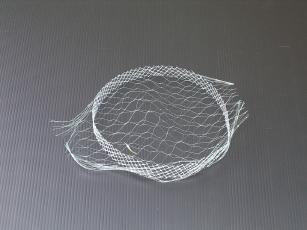
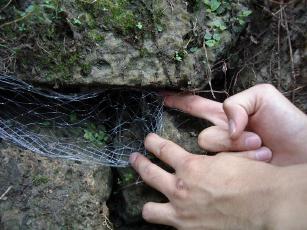
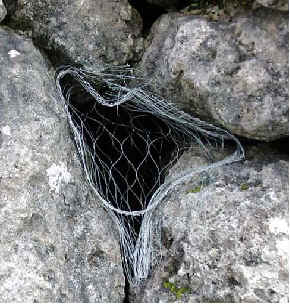
Fishing net fixed on iron frame Expand the frame in the gap Installed trap
(4)
Easy
points at utilization
Need only small amount of net
Hardly becoming obstacles at weeding
Able to target the gaps of Habu's
home at pin-point scale
(5) Disadvantages
Hard to install firmly
Possible to loose entangled Habu taking the trap from the
gap Habu will
die but you can not confirm the result
(1)
Utilize the whole unit of net
For example, fishing net shown in the
material is 100 m in length (60 cm to 1 m in height)
(2) Suitable
spots
for installation
Just inside the woodlands with many Habu, beside a
residential area, institute (school and etc.) and farming area
Select a
point several meters inside the woodland and easy to install the long
net.
Select a route to set the net easily,
winding rout will do.
(3) How
to install
Hang the top of the net to tree branches at several meters
interval.
Cut the tips of branches of small trees at height of 50 cm
to 1 m, and hang the net.
Before these works, clean the
route of obstacles.
Keep the top of the net more than 20 cm high from
the ground to catch Habu.
When the net bottom is above the ground
suppress it with stones and etc.
(4) Check
the net once or twice pre
year, including post-typhoon season
You can check the
effectiveness of the trap by searching bones of Habu at the bottom of
the net.
Be careful, because Habu has a high chance to be alive in
the
woodlands.
(5)
Easy
points at
utilization
High possibility to capture Habu by a long length of the
net.
Need not to expand the net fully.
Effective with rips or
slacks on the net.
Few approaches by children
Need not to weed.
(6)
Disadvantage
Unsuited for users unaccustomed to works in
woodlands.
Loosing effectiveness of several parts of net by fallen
thick bough or trees.
High possibility to encounter live Habu.
Hard to find bones of Habu.
In the world there are many venomous or invasive snake species causing problems for human health and native animals. About 2.5 millions of people are envenomated by snakes mainly in tropical and subtropical regions. In these regions preparations of anti-venoms for victims bitten by snakes are regarded to be urgently necessary, for no one expected to get some methods to control snake population effectively. But it is better to reduce the frequencies of bites through keeping the snake densities low. The net-trap methods could not be utilized to all of the problem snakes, but could be tested easily in a small scale for any snake species. In many cases the net-trap method could be applicable with respect to its cost effectiveness and ease of use.
The net-trap method is applicable
for
the control of problem snake species with a similar or larger trunk
girth to the
head. Snake species with small head and
thick trunk becomes a target of the trap easily. While those species with large head,
like Habu, can also be entangled with stomach contents.
You
need to find nets of suitable mesh size, which entangle the target
venomous or invasive snake species. Most suitable mesh size
is a
little larger than the head of large adult snakes. That is,
total
length of 4 sides of the mesh is little longer than the maximum girth
of head.
For example: (mesh size)
= ((head girth) + 3 mm) / 4].
When
head girth of large adult snake: 73 mm,
Mesh size = (73 + 3) / 4 = 19 mm.
Select
19 x 19 mm mesh net,
but do preliminary tests (laboratory or small scale in the fields).
We do
not need to catch the largest adults which are less than 5% in the
snake population. In the case that the snake species has
trunk thicker than
its head without preys in stomach, the mesh size can be larger than the
example shown above.
In Okinawa few native animals other than Habu were caught by the
net-traps. In other regions where the venomous snakes are
harmful
in residential and farming areas, you could utilize the traps without
co-capturing many non-problem animals in these areas with few wild
animals. Stop utilization and remove the traps, when many
wild
animals have been caught. Choose other methods, like
snake-fences, instead of the traps, if possible. Pay attention
not to utilize the net-traps in natural environments. The spots
of trap-installation should be restricted to those with daily human
activities, where the densities of venomous snakes are high and the
densities of other wild lives are low. Utilizing the traps with
these restricted manners will not cause large ecological
problems. There may still remain some problems at using them in
these manners, but we can try to utilize them carefully when the
effects of traps to reduce the risk of snakes are much more than the
problems.
When the children are not trained to the venomous snakes, do
not set the traps within the activity
areas of children.
You can use various kinds of net for net-traps, fishing gill
nets, other fishing nets, nets
to protect farming
products against birds and nets for golf training. Search
discarded nets of your target mesh size, and then the material cost
could become zero.
The methods of installing traps might be similar to those of
Habu. In
the cases of arboreal snake species you can trap them by the
nets
set around tree trunks, as the rat snake (see the following reference). Neal,
J.C., W.G. Montague and D.A. James. 1993. Climbing by black rat
snakes on cavity trees of red-cockaded woodpeckers. Wildlife Society
Bulletin 21:160-165.